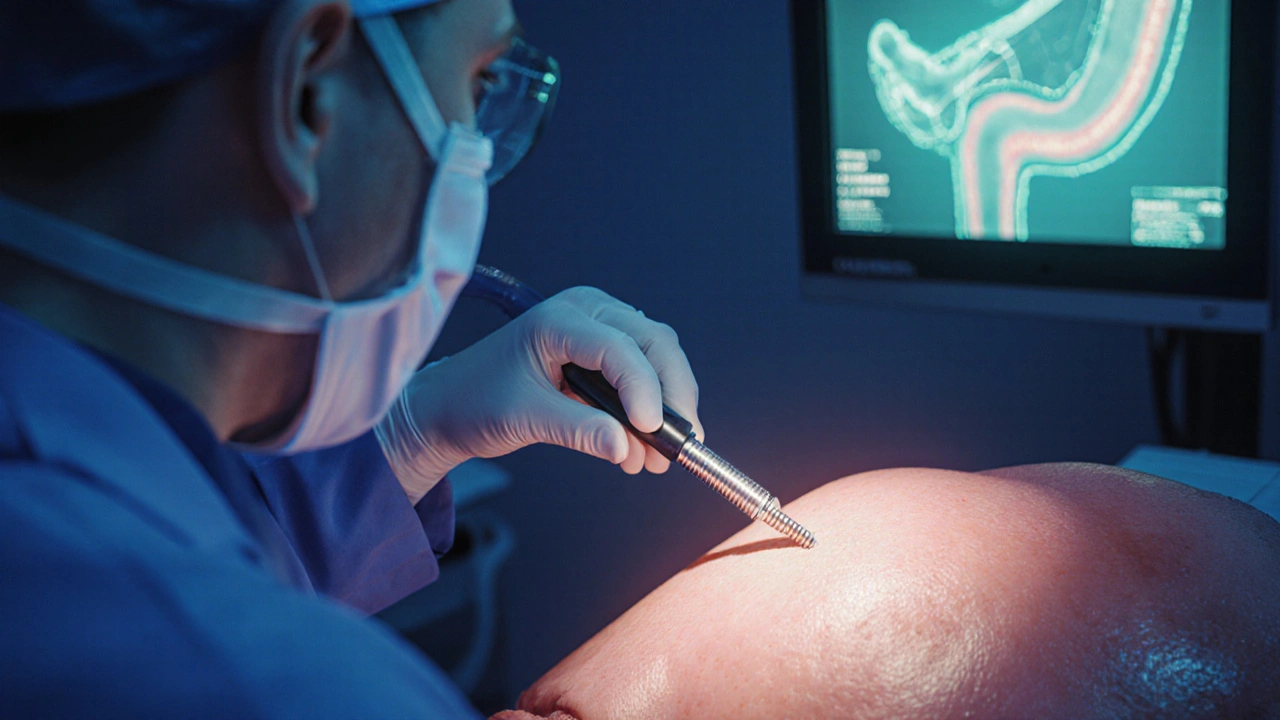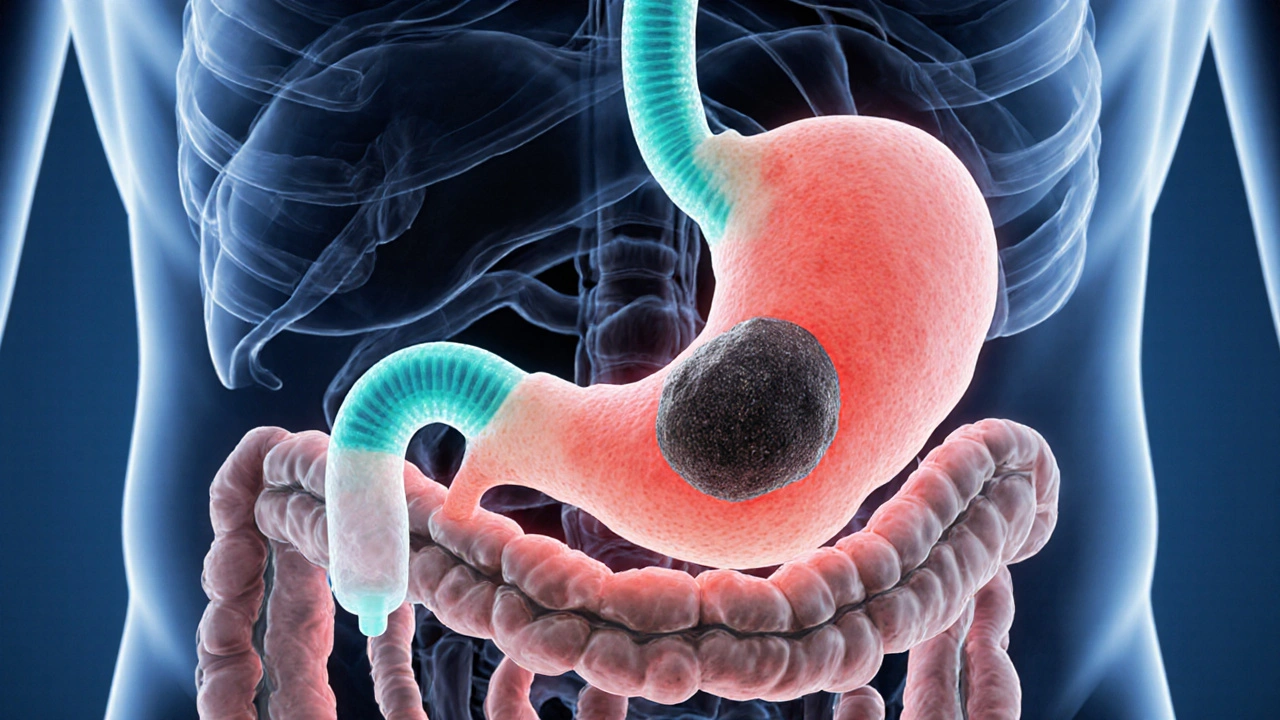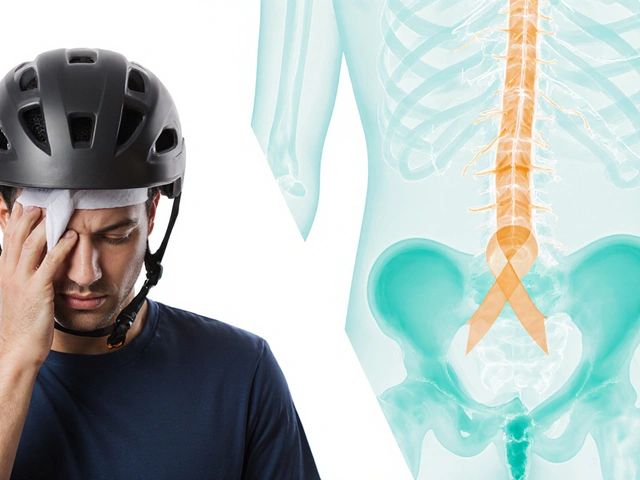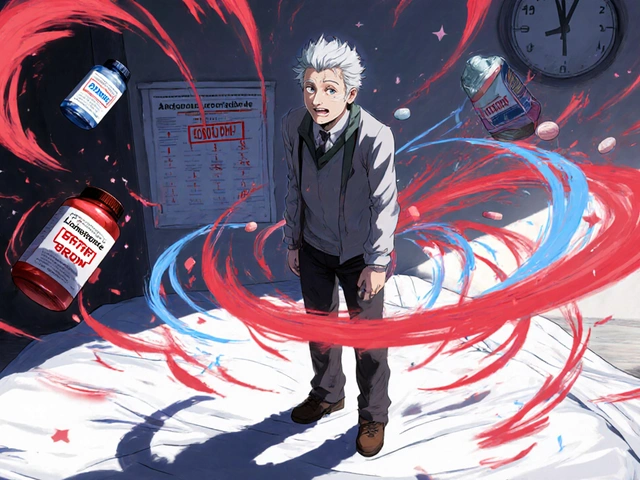Pancreatic Pain Symptom Checker
Symptom Assessment Tool
Answer the questions below to assess your symptoms and determine appropriate next steps for pancreatic duct blockage.
Your Results
Next Steps
Key Takeaways
- Identify the cause of pain - inflammation, pressure, or infection.
- Start with simple at‑home measures: hydration, low‑fat diet, and over‑the‑counter NSAIDs.
- Seek medical evaluation if pain is severe, persistent, or accompanied by fever, jaundice, or vomiting.
- Procedures such as ERCP with stent placement can relieve ductal pressure and dramatically cut pain.
- Regular monitoring and lifestyle tweaks help prevent future blockages.
Understanding Pancreatic Duct Blockage
When the main conduit that carries digestive enzymes from the pancreas is clogged, the result is pancreatic duct blockage. The blockage can be caused by gallstones, scar tissue, or thick secretions. The backup creates pressure inside the pancreas, often leading to pancreatitis - an inflammation that is the main driver of pain.
How Blockage Turns Into Pain
The pancreas sits behind the stomach and releases enzymes into the small intestine. If the duct is obstructed, enzymes cannot flow out, and they start to digest the pancreas itself. That chemical irritation, combined with swelling, triggers sharp, burning abdominal pain that may radiate to the back. In addition, the body’s stress response releases hormones that heighten pain perception.

Immediate Self‑Care Measures
Before you see a doctor, these steps can lower discomfort:
- Hydration: Sip clear fluids every hour; water helps thin secretions.
- Low‑fat diet: Fat stimulates pancreatic secretions, so stick to low‑fat diet foods like broth, rice, steamed veggies, and lean proteins.
- Heat therapy: A warm pack on the upper abdomen can relax muscles and reduce referred back pain.
- Over‑the‑counter NSAIDs: NSAIDs such as ibuprofen (200‑400mg every 6hours) curb inflammation. Avoid if you have ulcers or kidney issues.
If NSAIDs aren’t enough, a short course of opioid analgesics may be prescribed, but they carry risks of dependence and constipation, so use only under supervision.
Medical Interventions that Target the Blockage
When self‑care fails, clinicians aim to relieve the pressure inside the duct.
- Imaging: An abdominal CT scan or MRCP (magnetic resonance cholangiopancreatography) maps the blockage.
- ERCP: Endoscopic retrograde cholangiopancreatography (ERCP) threads a flexible tube through the mouth to the pancreas. The doctor can flush out debris, place a pancreatic stent, or dilate strictures.
- Pancreatic enzyme replacement therapy (PERT): Once the duct is open, PERT reduces the pancreas’s workload, lowering pain recurrence.
Stent placement often provides immediate relief because it creates a bypass for the blocked segment, allowing enzymes to flow freely. Stents are usually made of plastic or metal and stay in place for weeks to months before removal.
Choosing the Right Pain‑Relief Strategy
| Option | Mechanism | Typical Dose/Duration | Pros | Cons |
|---|---|---|---|---|
| NSAIDs | Reduce inflammation via COX inhibition | 200‑400mg every 6h, max 1week | Readily available, inexpensive | GI irritation, kidney impact |
| Opioid Analgesics | Bind to CNS opioid receptors, dampening pain signals | Low‑dose morphine 2‑5mg q4‑6h PRN | Strong pain control | Dependence, constipation, respiratory depression |
| Endoscopic Stent (via ERCP) | Physically opens duct, bypasses obstruction | Single procedure, stent left 4‑8weeks | Addresses root cause, rapid relief | Invasive, procedure‑related risks |
| Pancreatic Nerve Block | Local anesthetic injected near celiac plexus | One‑time injection, effects last 1‑2months | Effective for chronic pain | Technical skill required, possible temporary numbness |
For most patients, start with NSAIDs and dietary tweaks. If pain persists beyond a few days or worsens, discuss ERCP and stenting with a gastroenterologist. Nerve blocks are usually reserved for chronic cases when other measures fail.
Lifestyle Tweaks that Keep Pain at Bay
Long‑term success hinges on habits that reduce pancreatic stimulation:
- Eat small, frequent meals rather than large feasts.
- Limit alcohol - even moderate intake can trigger spasms in a compromised duct.
- Maintain a healthy weight; excess abdominal fat increases pressure on the pancreas.
- Consider a probiotic supplement to support gut flora, which may lower inflammation.
When you’re hungry, choose clear broths, boiled potatoes, and skin‑less chicken. Avoid fried foods, creamy sauces, and high‑fat cheeses.
When to Seek Immediate Medical Help
Although many episodes resolve with conservative care, certain warning signs demand urgent attention:
- Severe, unrelenting abdominal pain lasting more than 8hours.
- Fever above 38°C (100.4°F) indicating possible infection.
- Jaundice - yellowing of skin or eyes, suggesting bile duct involvement.
- Vomiting that prevents you from keeping fluids down.
If any of these appear, head to the emergency department for prompt imaging and possible drainage.
Quick Checklist for Managing Pain
- Stay hydrated -≥2L water daily.
- Follow a low‑fat diet -<20g fat per meal.
- Use NSAIDs for the first 48hours if no contraindications.
- Schedule imaging (CT or MRCP) if pain persists beyond 72hours.
- Discuss ERCP and stent placement with a gastroenterologist if imaging shows a blockage.
- Track pain intensity on a 0‑10 scale to help clinicians gauge treatment response.
Frequently Asked Questions
What causes pancreatic duct blockage?
Common culprits are gallstones that slip into the pancreatic duct, scar tissue from previous inflammation, and thick protein plugs that form when pancreatic secretions become overly viscous.
Can diet alone relieve the pain?
A low‑fat diet reduces pancreatic stimulation and can lessen pain, but it won’t fix an actual physical blockage. Diet is a supportive measure alongside medical treatment.
Is ERCP safe?
ERCP is generally safe when performed by experienced endoscopists. Risks include pancreatitis (about 5‑10% of cases), infection, and rare perforation. The benefits of relieving ductal pressure usually outweigh these risks.
How long does a pancreatic stent stay in place?
Stents are typically left for 4‑8weeks, after which they are removed or replaced during a follow‑up endoscopy.
Should I avoid all painkillers?
No. NSAIDs are often first‑line because they target inflammation directly. Opioids are reserved for severe pain or when NSAIDs are contraindicated.
Managing pancreatic duct blockage pain management is a mix of quick self‑care, targeted medical procedures, and long‑term lifestyle tweaks. By spotting the warning signs early and working closely with a gastroenterology team, most people can get back to daily life without constant agony.






Rebecca M
October 12, 2025 AT 20:34First and foremost, the guide omits a crucial piece of information: the role of pancreatic enzymes in exacerbating pain, which, frankly, should have been highlighted at the very beginning; secondly, the recommendation to use NSAIDs without a disclaimer about potential gastrointestinal bleeding is, at best, careless, and at worst, dangerous. Moreover, the phrase "low‑fat diet" is vague; it ought to specify macronutrient ratios, because a vague directive leads to misinterpretation. Additionally, the assertion that "stent placement often provides immediate relief" lacks nuance-patients can experience post‑ERCP pancreatitis, a fact conspicuously absent from the text. Furthermore, the checklist fails to mention the importance of monitoring serum amylase and lipase levels, which are essential biomarkers. In addition, the guide neglects to advise patients on the potential need for vitamin supplementation after prolonged low‑fat diets, which can lead to deficiencies. Also, the recommendation of "clear fluids every hour" could be misread as an endorsement of unlimited fluid intake, which is not advisable for patients with concurrent cardiac conditions. Besides, the statement that "opioid analgesics may be prescribed" should be accompanied by a warning about dependence and constipation. Moreover, the description of ERCP omits the possibility of ductal injury, a complication that deserves mention. In short, while the guide is comprehensive in many respects, it suffers from several oversights that could mislead patients; attention to these details would markedly improve its utility.
Bianca Fernández Rodríguez
October 21, 2025 AT 19:14Honestly, I think all this "low‑fat" nonsense is just a marketing ploy. If you cut fat, you cut flavor, and you end up eating bland mush that does nothing for your spirit. Plus, the whole "stay hydrated" line is overrated-most people can't even drink that much water without feeling bloated. And who really trusts a "heat pack"? It's just a cheap hack that people use to feel like they're doing something. The guide also forgets to mention that most of these procedures are just ways for hospitals to make money.
Anyway, if you're reading this, maybe just ignore the whole thing and eat whatever you want.
Jessica Gentle
October 30, 2025 AT 17:54Hey there! I totally get how overwhelming this can feel, so I wanted to add a couple of friendly tips. First, keep a simple pain‑log-note the time, intensity, and what you ate that day. It helps your doctor see patterns faster. Second, try sipping ginger tea; many folks find it soothing for the stomach and it’s low in fat. Lastly, if you ever feel like the pain spikes suddenly, a warm compress for 10‑15 minutes can relax the muscles around the pancreas. You’ve got this, and don’t hesitate to reach out if you need more ideas!
Samson Tobias
November 8, 2025 AT 16:34I understand how scary pancreatic pain can be, and I want to encourage you to stay proactive. Maintaining a regular eating schedule, even with small portions, can prevent sudden enzyme surges. Pair that with gentle walks after meals to aid digestion. If you notice any new symptoms, contact your healthcare team promptly-early intervention makes a big difference. Remember, every step you take toward managing your health counts, and you’re not alone in this journey.
Alan Larkin
November 17, 2025 AT 15:14Alright, let’s get straight to the point-how many times a day are you actually checking your hydration levels? Because if you’re only sipping water when you feel thirsty, you’re probably not doing enough. Also, I’m curious: do you track your stool consistency? It’s a golden metric for pancreatic health that many ignore. 😜 On a side note, the “low‑fat diet” suggestion is fine, but you could spice it up with some herb‑infused broths to keep meals interesting. Keep me posted on how your regimen evolves! 🙌
John Chapman
November 26, 2025 AT 13:54While the original guide is commendable for its breadth, it regrettably glosses over the sophisticated interplay between pancreatic enzyme secretion and neurohormonal regulation-a nuance that only a practitioner with a robust understanding of gastroenterology can truly appreciate. The omission of a detailed mechanistic explanation, particularly regarding cholecystokinin’s role, undermines the guide’s scholarly rigor.